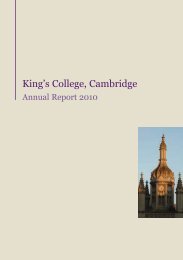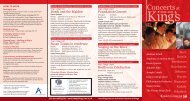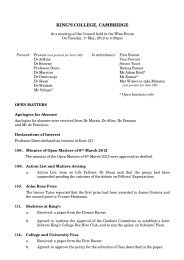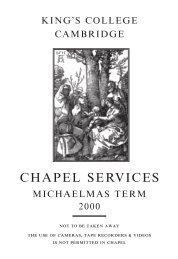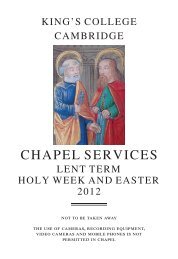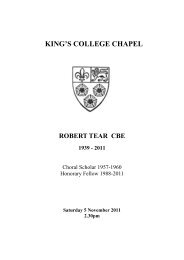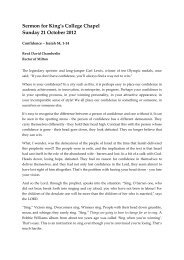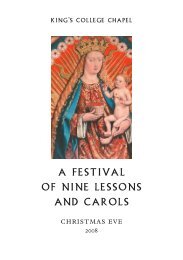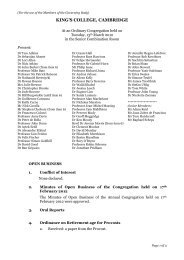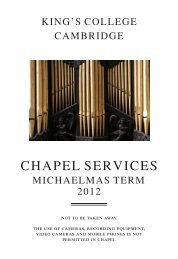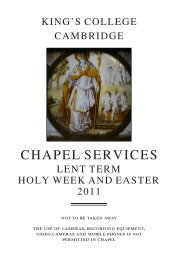Part 2 (Obituaries) - King's College - University of Cambridge
Part 2 (Obituaries) - King's College - University of Cambridge
Part 2 (Obituaries) - King's College - University of Cambridge
Create successful ePaper yourself
Turn your PDF publications into a flip-book with our unique Google optimized e-Paper software.
He participated not only in the D-Day operations, the ill-fated Arnhem attack<br />
and the Rhine crossing, but also in SOS/SAS missions to Norway.AfterV-E Day<br />
David was sent with his squadron to eastern India on a mission to fly across<br />
Burma and deliver supplies to the Chinese Republican forces under the<br />
Generalissimo Chiang Kai-shek. He had to contend with the eastern end <strong>of</strong> the<br />
Himalayan mountains, or “The Hump”, with woefully inaccurate maps.<br />
David left the military with a Distinguished Flying Cross and came to King’s<br />
in 1947 to study Mechanical Science (as engineering was then called). His<br />
academic prowess won him a place at a summer-exchange program with the<br />
Massachusetts Institute <strong>of</strong>Technology in 1949. During his student days he was<br />
an active member <strong>of</strong> the <strong>University</strong> Gliding Club, this time flying civilian<br />
versions <strong>of</strong> the motorless gliders that he had once tugged with four-engine<br />
Halifax bombers during the war. With a First, the Aeronautics Prize and fond<br />
memories <strong>of</strong> King’s, David eventually left <strong>Cambridge</strong> after completing his<br />
undergraduate degree.<br />
He returned to the RAF, working on the development <strong>of</strong> supersonic planes at<br />
Farnborough. But life in the peacetime RAF <strong>of</strong>fered little excitement<br />
compared to that <strong>of</strong> wartime, especially for a dynamic personality like David’s.<br />
Soon he left the RAF for the second time, now for the fast-paced world <strong>of</strong><br />
insurance brokerage in the City. David proved equally adept in his pr<strong>of</strong>essional<br />
life as he had been in flying or in his scholarly pursuit. He eventually became<br />
the Director <strong>of</strong> the insurance company Sedgwick Forbes and later helped draft<br />
the new insurance legislation <strong>of</strong> the Cayman Islands.<br />
The passion for flying, and gliding in particular, remained a constant in<br />
David’s life. It was on the tarmac <strong>of</strong> the Redhill Aerodrome in Surrey that he<br />
met his wife, Barbara, whom he married in 1952. In the 1950s David,<br />
together with some friends, started a gliding syndicate championing a<br />
pioneering design in which the glider had a retractable undercarriage. The<br />
first meeting was in the <strong>Cambridge</strong> home <strong>of</strong> Dr Alice Roughton, and it was<br />
after the crest painted on the side <strong>of</strong> her old Rolls Royce that the syndicate’s<br />
glider was named Pigs Rampant. All the subsequent gliders <strong>of</strong> the syndicate<br />
were given pigs’ names and David started a collection <strong>of</strong> toy pigs, winged if<br />
99<br />
OBITUARIES



